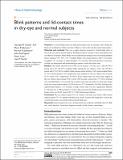| dc.contributor.author | Ousler, George W | en_US |
| dc.contributor.author | Abelson, Mark B | en_US |
| dc.contributor.author | Johnston, Patrick R | en_US |
| dc.contributor.author | Rodriguez, John | en_US |
| dc.contributor.author | Lane, Keith | en_US |
| dc.contributor.author | Smith, Lisa M | en_US |
| dc.date.accessioned | 2014-07-07T18:14:15Z | |
| dc.date.issued | 2014 | en_US |
| dc.identifier.citation | Ousler, George W, Mark B Abelson, Patrick R Johnston, John Rodriguez, Keith Lane, and Lisa M Smith. 2014. “Blink patterns and lid-contact times in dry-eye and normal subjects.” Clinical Ophthalmology (Auckland, N.Z.) 8 (1): 869-874. doi:10.2147/OPTH.S56783. http://dx.doi.org/10.2147/OPTH.S56783. | en |
| dc.identifier.issn | 1177-5467 | en |
| dc.identifier.uri | http://nrs.harvard.edu/urn-3:HUL.InstRepos:12406927 | |
| dc.description.abstract | Purpose To classify blinks in dry eye and normal subjects into six subtypes, and to define the blink rate and duration within each type of blink, as well as the total lid-contact time/minute. Materials and methods This was a single-centered, prospective, double-blind study of eleven dry-eye and ten normal subjects. Predefined subjects watched a video while blinks were recorded for 10 minutes. Partial blinks were classified by percentage closure of maximal palpebral fissure opening: 25%, 50%, 75%. Complete blinks were characterized as full (>0 seconds), extended (>0.1 seconds), or superextended (>0.5 seconds). The mean duration of each type of blink was determined and standardized per minute as total lid-contact time. Results: Total blinks observed were 4,990 (1,414 normal, 3,756 dry eye): 1,809 (50.59%) partial and 1,767 (49.41%) complete blinks among dry-eye subjects versus 741 (52.90%) partial and 673 (47.60%) complete blinks among normal subjects. Only superextended blinks of ≥0.5-second duration were significantly more frequent in dry-eye subjects than normals (2.3% versus 0.2%, respectively; P=0.023). Total contact time was seven times higher in dry-eye subjects than normals (0.565 versus 0.080 seconds, respectively; P<0.001). Isolating only extended blinks (>0.1 second), the average contact time (seconds) was four times longer in dry-eye versus normal subjects (2.459 in dry eye, 0.575 in normals; P=0.003). Isolating only superextended blinks (>0.5 seconds), average contact time was also significantly different (7.134 in dry eye, 1.589 in normals; P<0.001). The contact rate for all full closures was 6.4 times longer in dry-eye (0.045 versus 0.007, P<0.001) than normal subjects. Conclusion: Dry-eye subjects spent 4.5% of a minute with their eyes closed, while normal subjects spent 0.7% of a minute with their eyes closed. Contact time might play a role in the visual function decay associated with increased blink rates. | en |
| dc.language.iso | en_US | en |
| dc.publisher | Dove Medical Press | en |
| dc.relation.isversionof | doi:10.2147/OPTH.S56783 | en |
| dc.relation.hasversion | http://www.ncbi.nlm.nih.gov/pmc/articles/PMC4015796/pdf/ | en |
| dash.license | LAA | en_US |
| dc.subject | keratoconjunctivitis sicca | en |
| dc.subject | dysfunctional tear syndrome | en |
| dc.subject | interblink interval | en |
| dc.subject | blink rate | en |
| dc.subject | visual function | en |
| dc.subject | visual tasks | en |
| dc.subject | diagnostic model | en |
| dc.subject | eyelid closures | en |
| dc.subject | microsleeps | en |
| dc.title | Blink patterns and lid-contact times in dry-eye and normal subjects | en |
| dc.type | Journal Article | en_US |
| dc.description.version | Version of Record | en |
| dc.relation.journal | Clinical Ophthalmology (Auckland, N.Z.) | en |
| dash.depositing.author | Abelson, Mark B | en_US |
| dc.date.available | 2014-07-07T18:14:15Z | |
| dc.identifier.doi | 10.2147/OPTH.S56783 | * |
| dash.contributor.affiliated | Abelson, Mark | |


